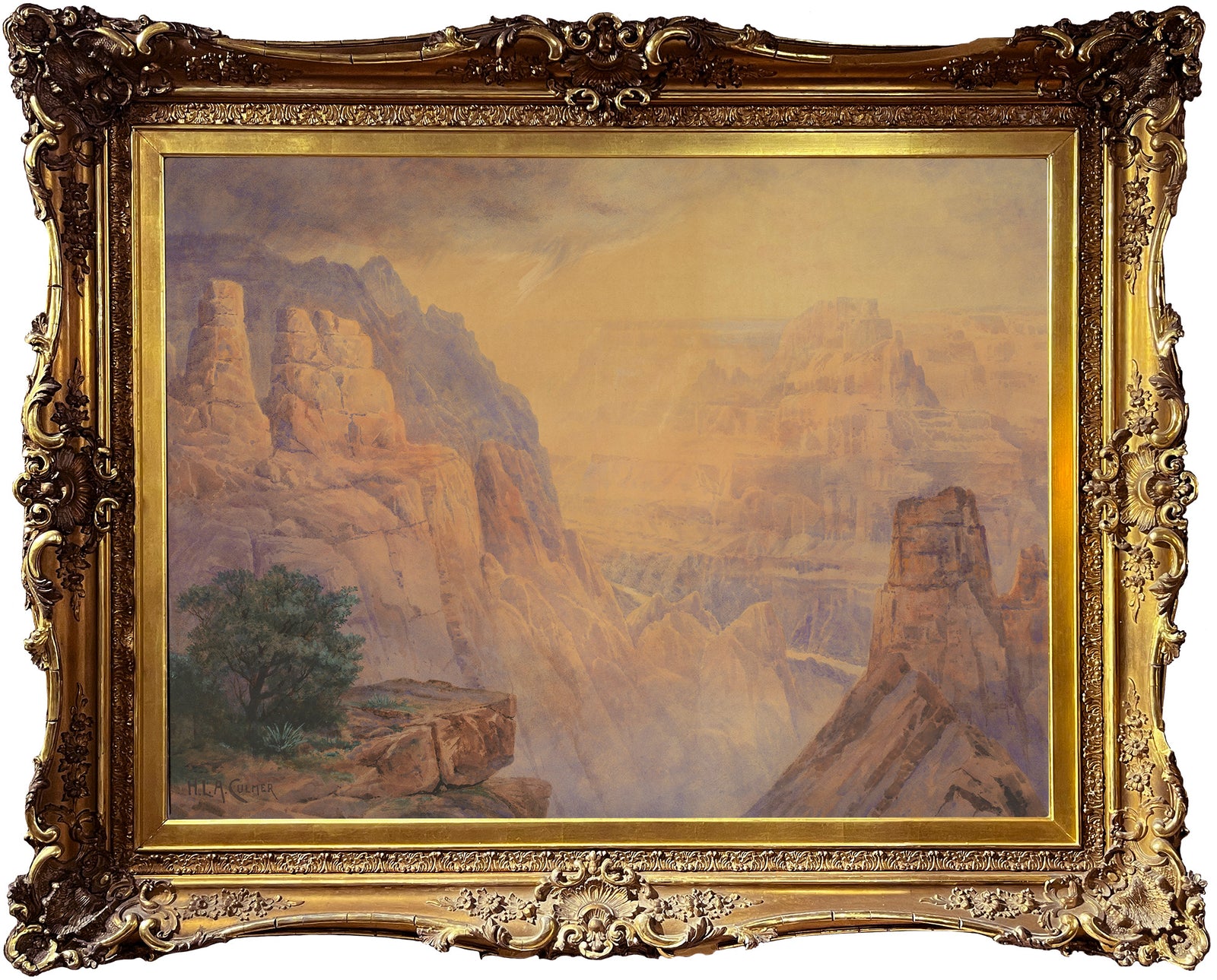H.L.A. Culmer, Grand Canyon of the Colorado in Arizona

H.L.A. Culmer Grand Canyon of the Colorado

Henry Lavender Adolphus Culmer (Kent, England, 1856 - 1914, Salt Lake City) Grand Canyon of the Colorado (1903) Watercolor. 30 x 40 in. Anthony’s Fine Art & Antiques, Salt Lake City, UT.
Provenance
1904 World’s Fair
Collection of Colonel Edwin F. and Suzie Holmes (a.k.a. Amelia’s Palace) Salt Lake City, Utah
Private Collection
Culmer was the first artist to see and paint Utah’s southern regions. An explorer, civic leader, writer, and entrepreneur, he used art to promote knowledge and development of Utah. Preceding the establishment of the United States National Parks Department in 1905, this painting, Grand Canyon of the Colorado River, was made by Culmer as a result of his exploration of Southern Utah and subsequently displayed at the St. Louis World’s Fair of 1904. The work led to commissions from National Geographic Society to further explore and depict Utah’s natural wonders.
In 1903, Culmer was invited to join an expedition to Southern Utah, sponsored by the Utah Commercial Club. At the time, the region was largely unmapped; but, rumors of land bridges and deep canyons led local leaders to sponsor a trip that would “make “accurate measurements, photographs, and descriptions, of Utah’s scenic beauties.” (Source: Uncredited. ”New President of Commercial Club has Closely Studied Public Problems,” Salt Lake Herald, 18 January 1903.) Culmer was the trip’s visual recorder, taking photographs and making sketches along the way.

H.L.A. Culmer (Kent, England - 1856 - 1914, Salt Lake City) Grand Canyon of the Colorado (c. 1904) 9 3/4 x 15 3/4 in. Watercolor. Springville Museum of Art, Springville.
Culmer made a smaller version of the same subject from a different angle, presumably in preparation for the grander work, which is held by the Springville Museum of Art. Both the study, and the final work, it seems Culmer was influenced by the large-scale watercolors of another artist explorer: Thomas Moran. Although the exact date is unknown, several contemporary sources suggest that Moran and Culmer met in 1879, while both artists were exploring mountainous regions of Utah. Both shared an affinity for dramatic views and painting in the unforgiving medium of watercolor, which allows for subtle transitions between values and temperatures that are difficult to communicate in oil.
Two principal paintings came from the expedition: Grand Canyon of the Colorado and Caroline Bridge, now located in the chambers of the Utah Supreme Court.

H.L.A. Culmer (1856 - 1914) Caroline Bridge (1905) Oil on canvas. 60 x 90 in. State of Utah Fine Art Collection, Supreme Court Chamber, State Capitol.
Of the two works, Grand Canyon of the Colorado was the more famous. It was first shown at the newly formed Utah Art Institute’s art show — the State’s foremost professional art competition — of 1903. Out of 500 submissions — including works by Edwin Evans, John Hafen, LA Ramsay, and John Fairbanks — Culmer’s work won first prize. As a result, it was then chosen to officially represent the State at the St. Louis World’s Fair. Called the “Louisiana Purchase Exposition,” the World’s Fair celebrated the centennial of the expansion of the United States and displayed works, like “Grand Canyon of the Colorado” to showcase the natural wonders of the West. It was visited by more than 20 million people, equivalent to 1/4 of the population of the United States.

On April 30, 1904—the opening day of the 1904 St. Louis World's Fair. Credit. The Atlantic Magazine.
Following the World’s Fair, the work was acquired from the State by Col. Edwin F. Holmes, President of the Commercial Club, and displayed in his home on the corner of South Temple and State street, then known as Amelia’s Palace.



National Geographic Magazine, No. 18, March 1907.
Largely due to his success at the World’s Fair, Culmer’s paintings and writings on Utah became the cover story of the March 1907 edition of the National Geographic Society. Titled “The Great Natural Bridges of Utah,” the article ends with the following “National Park Suggestion”:
“From all that is learned of this wonderful country, it is believed that its preservation and care should be undertaken by the United States Government, as in the case of Yellowstone National Park, so that roads may be opened and these greatest of the world’s natural bridges can be made accessible for the tourists from our own country and from all over the world . . .” (Source: National Geographic Magazine, No. 18, March 1907, 204)
Three years later, Rainbow Bridge National Park (later known as Canyon Lands) was created, followed by Bryce Canyon (1928), Arches (1929), and Capitol Reef (1937).



